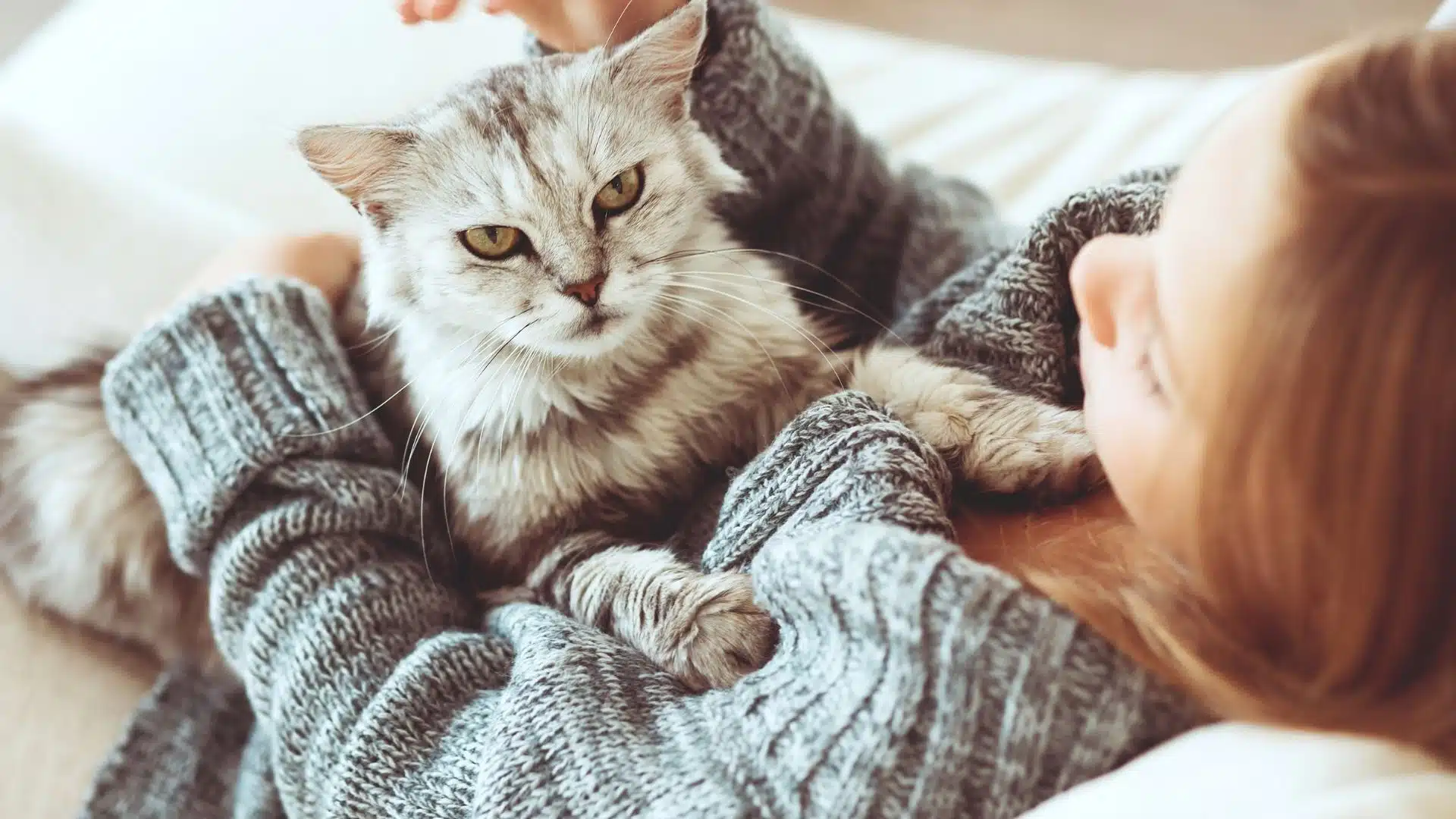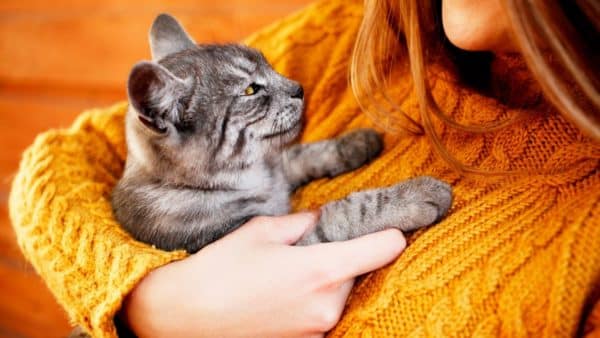

Kittens, adults, and senior cats are susceptible to many feline diseases. Therefore, it is quite difficult to put together a list of general symptoms that you should be on the lookout for. Additionally, it is even more challenging since cats are known for hiding the clinical signs of disease for as long as possible.
However, some obvious signs are listed below. If your cat exhibits any of these symptoms, it should be taken to the animal hospital as soon as possible:
Spread through a cat’s saliva, FIV is one of the deadliest and unfortunately, one of the most common viruses carried by outdoor cats. All cats are susceptible to developing this infectious condition, regardless of age or health status.
If they are in good health, some adult cats may not show any symptoms for several years. However, at some point, the cat’s immune system will stop working normally. A healthy cat that goes outside every day can come in direct contact with other cats who carry the virus. If your pet gets bitten by an infected cat, they might be diagnosed with Feline Immunodeficiency Virus (FIV) and have it for the rest of their life.
Feline Leukemia Virus (FeLV) is one of the deadliest and most contagious conditions of cats to date. It is also spread through the saliva of infected cats, so outdoor animals have a much higher likelihood of coming into direct contact with a potential carrier. The pathogen of this feline infectious disease can also be spread through feces, urine, and blood. Mother cats can also pass it to their kittens through milk.
Currently, there is no treatment for Feline Leukemia Virus (FeLV). Some of the symptoms that an infected cat might show are neurologic disorders, anemia, digestive health issues, and general malaise.
Is your pet safe?
1 in 3 pets will need emergency veterinary treatment each year and it is estimated a pet receives emergency care every 2.5 seconds in the U.S.
The average cost of treating a broken bone in dogs is $2,700. Cancer treatments? Up to $10,000.
It’s why so many pet owners say their biggest regret isn’t the vet bill—it’s not having pet insurance when they needed it most.
Ask yourself: “If an unexpected $5,000 vet bill hit tomorrow, could I afford it?”
If the answer is no, it’s time to get covered.
Take a look at Lemonade. They have a great app that actually works, they have an instant chatbot that is faster and, dare we say it, friendlier than most companies’ “real” customer service and a quick scroll through Reddit will uncover… people are really vibing with this brand.
So go check them out and take a look. It takes less than a minute.
Feline Rhinotracheitis is not a disease per se as veterinarians actually use the term to refer to a variety of pathogens that can cause upper respiratory infections. Whether caused by Calicivirus, Herpesvirus, Chlamydophila, Bordetella, or Mycoplasma, this type of upper respiratory infection is typically characterized by nasal discharge, sneezing, cough, ulcers, and fever.
Some cats might present enlarged lymph nodes or other symptoms of an upper respiratory tract infection, such as runny eyes. Rhinotracheitis is highly contagious and causes severe problems in large cat communities such as shelters.
Feline Infectious Peritonitis (FIP) is less common compared to the other viruses that cats may come in contact with throughout their life. However, it is incurable and more often than not, fatal, particularly when it affects kittens.
The disease is produced by a mutated form of the Feline Coronavirus which causes weight loss, fever, loss of appetite, and lethargy. There is a FIP vaccine available but it is a non-core shot, which is why some pet parents might feel like their cats might not get the infection.
Feline Panleukopenia (FP) is a quite dangerous infection that cats can get from pretty much anywhere in their environment. If they go outside and come into contact with a new cat that could be a carrier, they could develop the disease and severe symptoms.
In young cats, feline panleukopenia can be deadly. It produces a wide range of symptoms from anorexia and high fever to diarrhea and vomiting, nasal discharge, and lethargy. Most kittens and infected cats die as a result of severe dehydration rather than the infection itself.

Feline Calicivirus is an upper respiratory infection that affects a variety of cats from domestic to wild and exotic ones. Sneezing, conjunctivitis, and nose and eye discharge are the most common symptoms that cats can experience, but general complications such as fever aren’t uncommon, either.
An infected cat can pass this infection to other animals through their respiratory secretions. Sharing the same litter box can be a risk, too, although the virus is less likely to be eliminated through urine and feces. Consider using a cat litter that has a health indicator. This highly sophisticated cat litter will measure certain chemicals in your cat’s urine and give you a color-coded reading on their health.
Even though viral diseases in cats are without a doubt some of the most dangerous ones, bacterial ones can occur, too, and they can affect a cat’s life and well-being. Respiratory, digestive, and urinary tract infections are among the most common ones that a cat can develop at one point or the other.
If your cat is a relatively healthy animal, their immune system will function properly so that with the right treatment, they will be able to recover. Your veterinarian can treat most bacterial infections with a broad-spectrum antibiotic.
In any case, and even if these infectious pathogens are less dangerous compared to FeLV or FIV, for example, you should make sure that your cat gets the right tests that can reveal what pathogen has caused the disease. Following this procedure, the vet can send the testing samples to a laboratory where an antibiogram will be performed and that will reveal just what medication the germ is sensitive to.
This is the correct protocol for treating a bacterial infection in cats. Your veterinarian can administer a broad-spectrum antibiotic without further testing, but they could risk causing antibiotic resistance.
The answer to this question actually depends on the exact type of disease you suspect your cat has. For example, they might have Feline Leukemia Virus (FeLV), Calicivirus, Ringworm, Rabies, or any other illness that could be transmitted to a kitten or human.
First of all, you have to ask yourself several questions. Is the cat a potential danger to other people? If that’s the case, you have to call Animal Control as soon as possible. Infected cats may spread the rabies virus to many other people through bites in a somewhat limited amount of time.
On the other hand, if you see any symptoms that could lead you to believe that your cat might be suffering from viral infections or bacterial infections that might not pose a threat to humans, the best advice we have for you is to reach out to your veterinarian.
There are lots of tests that they can perform to tell exactly what health problem your kittens might be suffering from.
If you have some experience and have been a cat parent before, so you might know the symptoms of potentially deadly and highly contagious diseases such as FeLV, FIV, FIP, or other such feline infectious diseases, the best way of going about things is to isolate your cat.
Of course, take them to the vet, but when you come back home, create a safe and clean environment for them where they can rest away from the other cats you might own. Avoid using the same food and water bowls, accessories, blankets, and whatever else they might regularly share.

Even though ‘fleas’ are not a condition per se, they can be vectors of numerous diseases. For example, they can pass intestinal parasites to your cat which you can then get, too. They can also be vectors of the bacterium that causes cat scratch disease, which is another zoonosis.
Most cat owners choose to give their feline friends medication or apply topical solutions against fleas and ticks every 3 to 4 months. Talk to your veterinarian about what products they recommend.
Compared to fleas, scabies is less common. However, it can still be transmitted from cat groups to their pet parents.
Scabies is caused by a mite that burrows under the skin of humans and animals. It sounds scary and it’s anything but pleasant considering that the infection causes intense itching in both cats and humans. However, it is somewhat easy to treat through specific medications, ointments, and even washing solutions.
Since the parasites can linger in the cat’s living environment, it’s highly advised for you to clean your bedding, clothes, and everything in your house.
All cats are likely to have intestinal parasites at one point or the other, but some of them can be transmitted to humans.
Roundworms and hookworms are the most likely parasites that can be passed on to humans by cats.
We aren’t going to go into a lot of detail about the two main parasites that infected cats can transmit, Toxocara and Ancylostoma, but we are going to note that practicing good hygiene and making sure that you always wash your hands after handling cat feces can prevent these health issues.
Indoor cats are considerably less likely to get such a parasite from another cat that could live outdoors. Have a talk with your veterinarian to find out what animal dewormers they recommend and how often you should administer the treatment to your pet.

Cat Scratch Disease an infection is caused by a bacterium called Bartonella henselae. Kittens and adult cats can get it from other pets’ saliva or by being bitten by cat fleas.
The disease itself rarely produces health issues in our feline friends. A cat may experience inflammation and pain at the wound site, poor appetite, sore joints, a headache, or a slight fever. The local lymph nodes might grow in size in some cases.
Kittens are the main vectors of the disease in humans, which is why people who are immunocompromised are advised to avoid contact with young cats. Healthy people are likely to be asymptomatic if they do come in contact with the bacterium — but seniors, babies, and people with autoimmune disease can develop symptoms of the infection.
Pasteurella multocida is a bacterium that can be found in many cats’ mouths. The infection rarely causes any real issues in people especially since it can be treated with antibiotics.
However, depending on the bite site, its depth, and severity, the microorganism could end up in a person’s blood circulation, in which case it can cause sepsis or an infection of the heart valves.
Since the bacterium can be found in up to 70% of all cats in the world, cat owners should make sure they teach their pets not to engage in rough play and bite them.
Cats can be carriers of Toxoplasmosis and they can transmit it to their pet parents. Most cats become infected by eating small rodents or birds.
If you get this disease from an infected cat and you are pregnant, you might risk severe health complications. The parasite is eliminated in the environment by infected cats, so even if your own doesn’t eat small prey, they could get it by grooming their body after simply stepping on the ground outside.
However, one of the most common ways people can get Toxoplasma is not by coming into contact with their cats’ feces but by eating raw meat or drinking contaminated water. If your cat tests positive for Toxoplasma and you are pregnant, you should avoid handling their feces. If you have to handle their feses, use as much protection as possible (use gloves and disinfect everything).

Cat owners could become infected with the Salmonella genus from their feline friends, but most of the cases of this infection that are seen in North America are actually from eating contaminated food rather than coming in contact with cat feces.
Salmonellosis can usually resolve naturally, but in some cases, humans might need medical assistance. Like other types of infections, this disease is more common in outdoor pets as these cats may eat wild birds and animals that could have been infected.
It’s also worth noting that healthy cats can catch the germ from raw meat if they are fed a homemade raw diet. Feeding cats cooked food or commercial diets can largely prevent this infection.
Even though rabies has become a less common infectious disease of animals these days as pet owners now vaccinate their furry friends against it, it is still one of the most dangerous infectious diseases that cats and other species can get.
If your cat lives indoors and outdoors, she might come in direct contact with an infected animal that might carry the rabies virus.
Rabies affects a lot of parts of a cat’s body, especially the nervous system. This viral disease has no cure to date in any species, so by vaccinating your cat against it you will be protecting not just your pet, but also yourself and your family.
Some outdoor cats in the United States might have a higher likelihood of becoming infected depending on the area they live in. The rabies vaccine should be administered to all cats and dogs.
Most of us train our dogs when they are puppies to jump up on furniture. We think it’s harmless (and easier than always lifting them), but for dogs, couches and beds are very high compared to the size of their bodies.
Every time they jump it compresses their back and applies enormous force to their joints.
It’s no wonder that an incredible 80% of dogs experience arthritis or joint pain by only 7 years old.
Luckily, there is a vet-recommended solution.
It’s the PawRamp by Alpha Paw. An adjustable ramp that allows dogs to safely get on and off couches and beds. PawRamp makes joining you in bed or on the couch effortless and fun.
As a bonus, you can use code SAVE35 to get $35 off the PawRamp today.

The medical, nutritional, or behavioral advice we provide is intended for informational and educational purposes only. Our editorial content is not a substitute for formal or personalized medical advice from a veterinary professional. Only board-certified veterinary specialists who have examined your pet should diagnose medical conditions, provide personalized treatment, or prescribe appropriate medication. For questions regarding your pet’s health, or if your pet is exhibiting signs of illness, injury, or distress, contact your veterinarian immediately. Never disregard professional medical advice or delay in seeking it because of something you have read on our site.